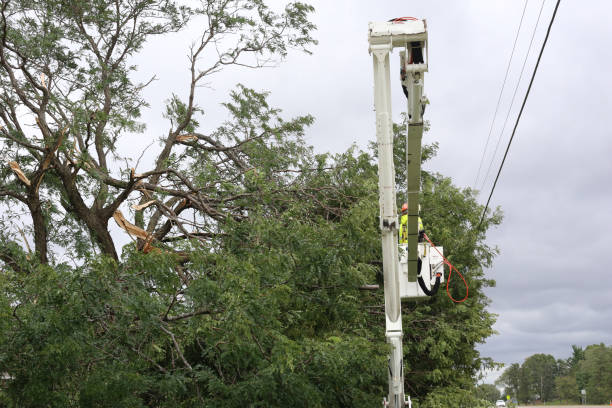Do you ever wonder what tree trimming is and why it is important? Well, you’re in the right place! Tree trimming is cutting or removing certain branches or parts of a tree to enhance its overall health, appearance, and safety. It is a crucial practice that every tree owner should be familiar with to ensure the well-being of their trees and the surrounding environment.
Regular tree trimming offers numerous benefits. Firstly, it helps maintain the tree’s structural integrity by eliminating weak or damaged branches that could fall and cause accidents or property damage. Trimming also promotes proper growth by removing any overgrown or overcrowded branches, allowing more sunlight and airflow to reach the tree’s core. This enhances its aesthetic appeal and improves its overall health and vitality. Additionally, tree trimming can help prevent the spread of diseases and pests, as it allows for early identification and removal of infected or infested branches. So, understanding tree trimming is essential if you want to keep your trees healthy, safe, and visually appealing!
Benefits of Regular Tree Trimming
You’ll be amazed at the benefits you can reap from regular tree trimming! One of the most important aspects is hiring professional tree trimmers. While you may think you can handle the task yourself, leaving it to the experts is best. Professional tree trimmers have the knowledge and experience to safely and effectively trim your trees, ensuring they remain healthy and beautiful.
Not only does regular tree trimming help maintain the aesthetic appeal of your landscape, but it also provides various environmental benefits. Trimming trees regularly helps improve their overall health and longevity. Removing dead or diseased branches prevents the spread of diseases and pests that can harm neighboring trees. This promotes a healthier ecosystem and reduces the risk of tree damage during storms or high winds.
Furthermore, regular tree trimming also contributes to the environment’s overall health. Trees play a vital role in purifying the air by absorbing carbon dioxide and releasing oxygen. When trees are properly trimmed, they can efficiently carry out this process, improving air quality in your surroundings. Additionally, trimmed trees allow more sunlight to reach the ground, promoting the growth of other plants and vegetation, further enhancing the ecosystem.
The importance of hiring professional tree trimmers cannot be overstated. Their expertise ensures the health and beauty of your trees while also providing environmental benefits. Regular tree trimming improves the overall aesthetics of your landscape and contributes to a healthier ecosystem. So, don’t hesitate to invest in professional tree pruning services – your trees and the environment will thank you!
Techniques for Proper Tree Trimming
Using the right tools and a gentle touch, it’s important to delicately shape and sculpt the branches to enhance the tree’s natural beauty. When it comes to tree trimming, it’s crucial to consider the specific needs and characteristics of different tree species. Each type of tree requires a different approach to achieve optimal results. For example, some trees may need to be pruned in the winter months when they are dormant, while others may require trimming during the spring or summer to promote healthy growth.
To properly trim trees, you will need the right equipment. Depending on the size and height of the tree, you may need a ladder or even a bucket truck to reach the higher branches. You will also need tools like pruning shears, loppers, and a saw. These tools allow you to remove dead or damaged branches carefully, thin out dense areas, and shape the tree as desired. It’s essential to ensure that your tools are sharp and clean to make clean cuts and minimize the risk of disease or infection.
Different tree species may require other techniques for proper trimming. For example, some trees may have a central leader, a dominant vertical branch, and it’s important to maintain this structure while removing any competing branches. Other trees may have a more open or spreading growth habit, and they may require thinning to allow more light and air to penetrate the tree’s interior. By understanding the specific needs of each tree species and using the right techniques, you can ensure that your tree trimming efforts are effective and beneficial for the overall health and appearance of the tree.
## Safety Considerations for Tree Trimming
Before starting, it’s essential to prioritize safety by considering potential hazards and taking necessary precautions. When it comes to tree trimming, using the right equipment is crucial. Ensure you have a sturdy ladder or aerial lift to reach the branches you need to trim safely. Additionally, wear appropriate personal protective equipment (PPE) such as gloves, safety glasses, and a hard hat to protect yourself from falling debris.
One of the most common tree-trimming mistakes is improperly inspecting the tree before starting the job. Look for signs of decay, disease, or structural issues that could make the tree unstable. Removing large branches from a hazardous tree can be extremely dangerous, as it increases the risk of the tree falling or causing injury. It’s also important to be aware of any electrical wires near the tree. Accidentally cutting into a live wire can lead to serious injury or even death, so always contact your utility company to ensure the area is safe before you begin.
Another common mistake to avoid is using dull or damaged tools. This can make the trimming process more difficult and increase the likelihood of accidents. Ensure your pruning tools, such as shears or saws, are in good condition and sharp. Using proper cutting techniques is also essential for safety. Avoid making improper cuts, such as leaving stubs or cutting too close to the trunk, as this can damage the tree and lead to infection or decay. You can ensure a successful and safe tree-trimming experience by prioritizing safety and avoiding these common mistakes.

